Forming planets around stars with non-solar composition
- 1Kapteyn Astronomical Institute, University of Groningen, The Netherlands
- 2Radboud University Nijmegen, The Netherlands
- 3SRON, The Netherlands
- 4SUPA, University of St Andrews, UK
- 5ETH Zurich, Switzerland
Abstract
We aim to understand the impact of different refractory element ratios such as Mg, Si, and Fe on the composition of planets. We use the thermodynamic equilibrium code GGchem to simulate the condensation of solids in a minimum mass solar nebula around main sequence G-type stars within 150pc. We extract the stellar elemental composition from the Hypatia database. We find that a lower Mg/Si ratio shifts the condensation sequence from forsterite and SiO to enstatite and quartz; a lower Fe/S ratio leads to the formation of FeS and FeS2 and little or no Fe-bearing silicates. Ratios of refractory elements translate directly from the gas phase to the condensed phase for T<1000K. However, ratios with respect to volatile elements (e.g. oxygen and sulphur) in the condensates – the building blocks of planets – differ from the original stellar composition. Our results can have important implications for planet interiors, which depend strongly on the degree of oxidization and the sulphur abundance.
1. Introduction
Planets form from solid material residing in the disk around a young star. Both the star and the disk are composed oft he same material (inherited from the collapsing cloud). In the inner disk (inside a few au), material is likely sublimating and solidifying repeatedly due to episodic accretion events and stellar luminosity peaks. Small variations from solar abundances (within 0.5dex), especially also for refractory elements, are ubiqutous in the solar neighborhood. The question is whether such small element abundance fluctuations have a noticeable impact on the composition of a planet condensing from the planet forming disk.
2. Methods
We selected from the Hypatia Database [4] single solar-type main-sequence stars within 150 pc. We select stars that have as complete as possible chemical abundance data and draw six sample stars, representative of the typical spreads in the elements ratios (see Fig. 1).
Figure 1: Ratios of the refractory elements Mg, Si and Fe, as well as S, for main-sequence G-type stars within 150pc. Black dots represent the location of the six sample stars. A red dot indicates a star for which we inferred missing abundances from the median of the known abundances.
We use the GGchem code developed by [2] and re-written and updated by [6]. The thermo-chemical data are taken from the NIST-JANAF and the geophysical SUPCRTBL databases. The code has been successfully benchmarked against the public TEA code [1]. Given a specific temperature and pressure, the code calculates the various molecules and condensates forming by minimizing the Gibbs free energy. We choose 24 elements (H, He, Li, C, N, O, Na, Mg, Al, Si, S, Cl, K, Ca, Ti, V, Cr, Mn, Fe, Ni, Zr, W, F, P), leading to 552 molecules and 241 condensates. We use the pT-profile of the Minimum Mass Solar Nebula from [3] and assume that different parts of the disk do not mix and that planets are forming in situ.
We sample the results of the condensation sequences by defining locations for the formation of hypothetical planets. Besides the current locations of Mercury, Venus, Earth, Mars, and the Asteroid belt in the Solar system, we also use 1000, 1250 and 1500K, mimicking that solar system planets likely formed at higher temperatures (dynamical evolution).
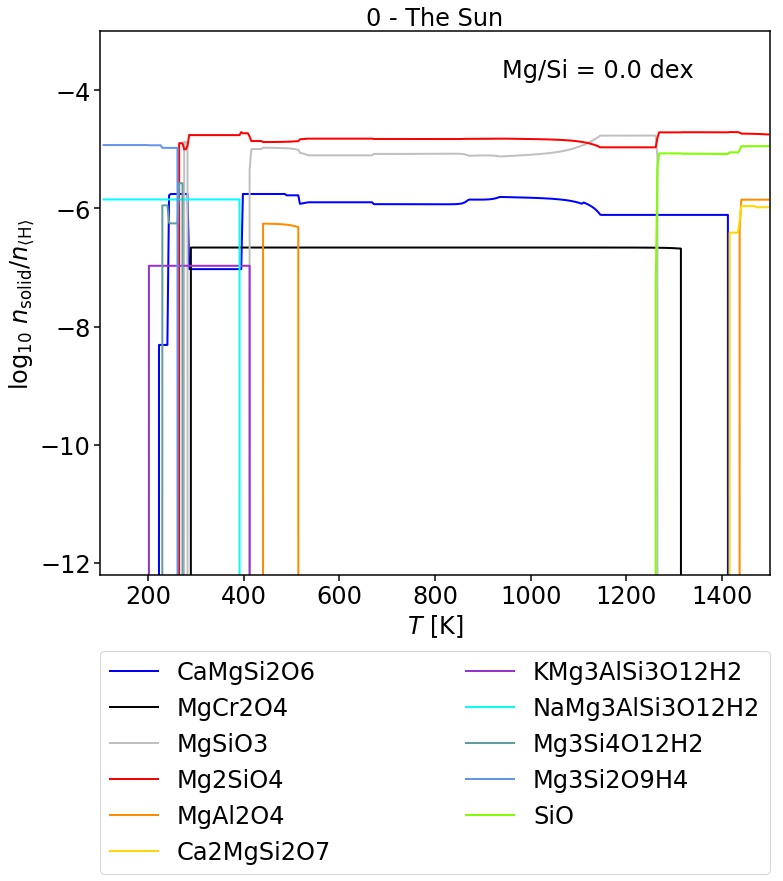
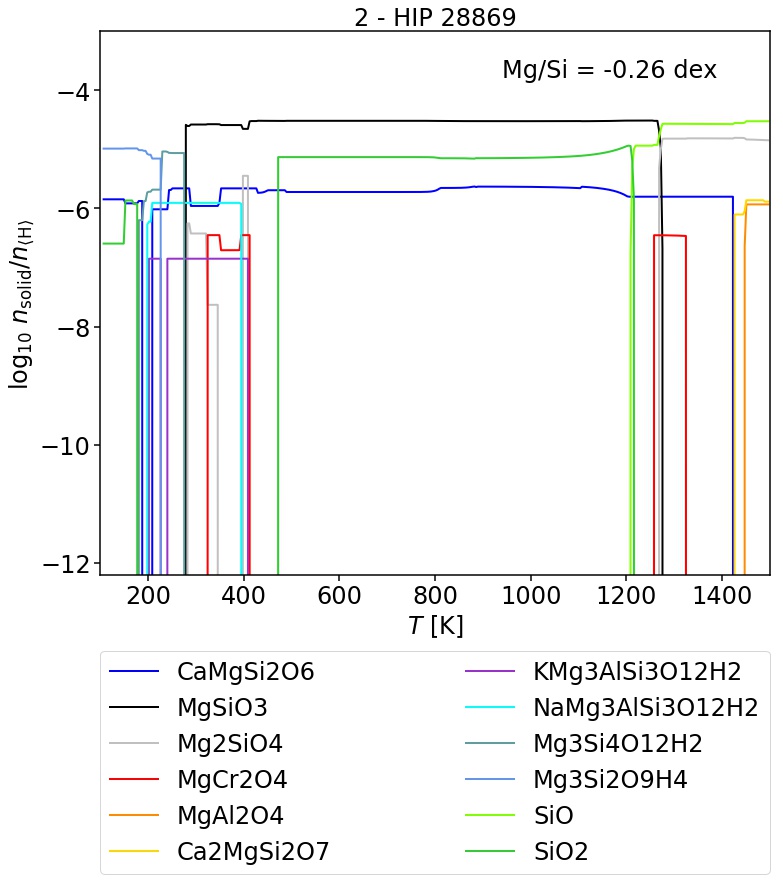
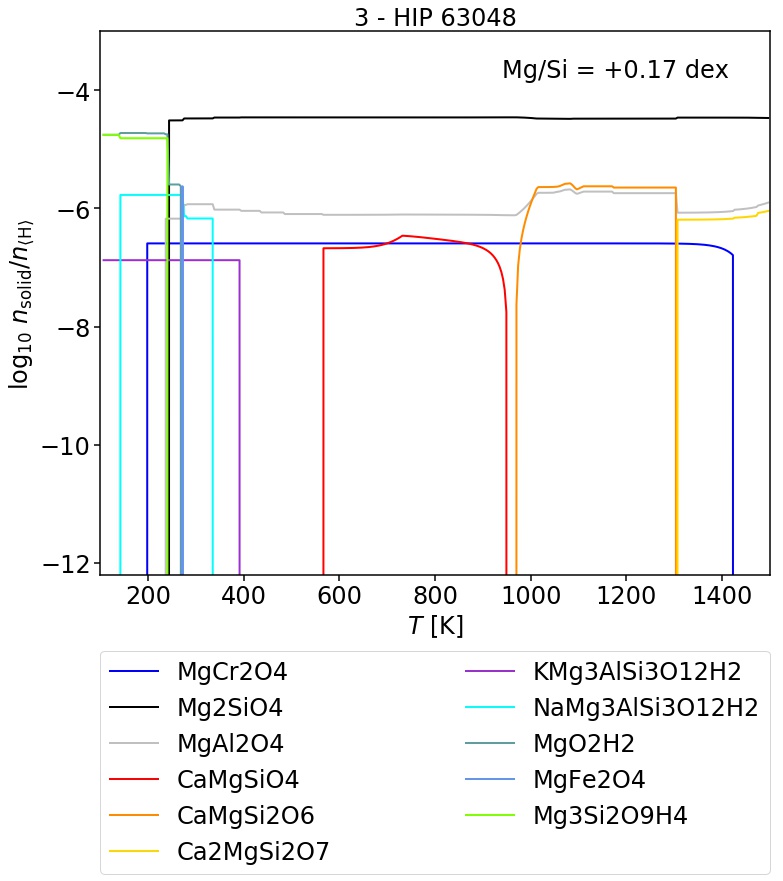
Figure 2: Condensation sequence for Mg-bearing species for the solar abundances and two extreme cases of Mg/Si ratio.
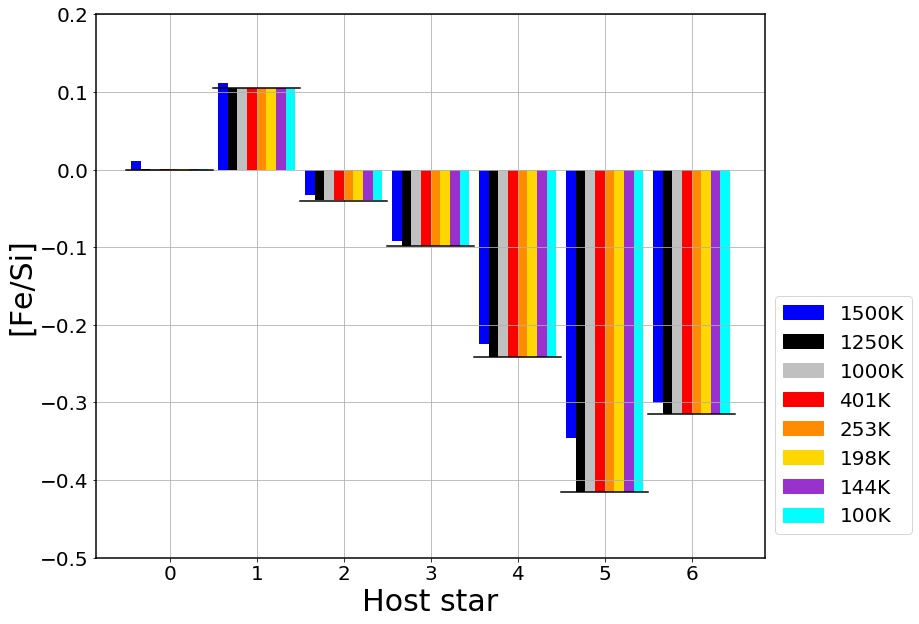
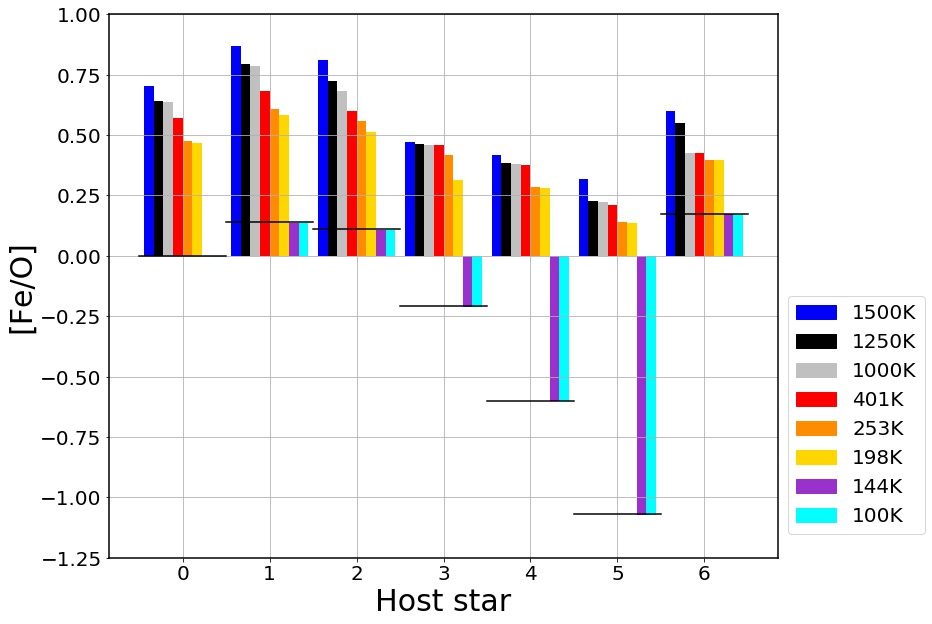
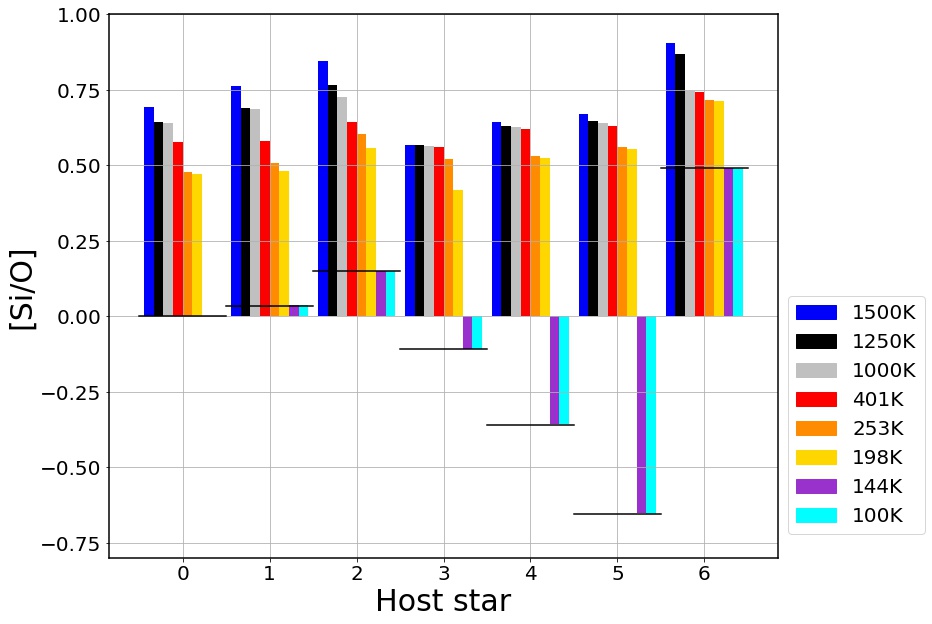
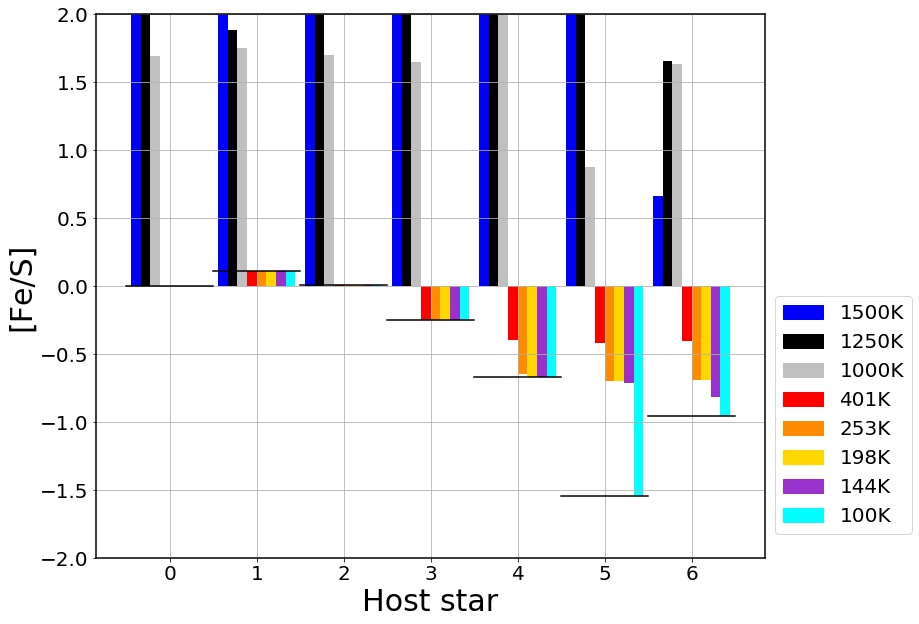
Figure 3: The element ratios in the condensed phase from which the hypothetical planets form (noted in legend by their respective temperatures). Ratios are normalised to the Solar values. The x-axis label represents the solar composition (0) and the six sample stars. The black horizontal line represents the initial value of the gas phase ratio.
3. Condensation sequences
Figure 2 shows the condensates containing magnesium for our six sample stars as a function of temperature. Iron condenses as metallic Fe at very high temperature, removing it from the gas phase. For solar abundances of Mg and Si, forsterite and enstatite are both abundant down to ~400K. Below that, they start to combine with hydrogen and form more complex silicates. This behavior is highly dependent on the initial Mg/Si ratio. At a high Mg/Si ratio of 0.17dex, forsterite stays the most abundant condensate down to 240K; enstatite, quartz and SiO are absent. For a low Mg/Si ratio of -0.26dex, the high temperature condensates are SiO and forsterite; below ~1250K, we find instead SiO2 and enstatite. For Fe/S≥-0.25dex, iron forms at low temperatures various types of Fe-bearing silicates while for Fe/S≤-0.67dex, Fe only forms FeS and FeS2.
4. Planet composition
Figure 3 shows that the refractory elements are directly inherited from the gas phase. This is not true for more volatile species such as sulphur and oxygen. Planets forming from condensates at temperatures ³1000K do not show much S, because the lowest temperature condensate FeS forms at ~700K. Planets form at ³250K, inside the snow line, in an environment where a fraction of the oxygen remains in the gas phase, leading to condensates with higher refractory/oxygen ratios. Planets forming outside the snow line can obtain ratios equal to the initial gas phase.
5. Conclusions
Our results show that planets could have more reduced interiors and an Fe/S ratio different from the initial gas phase. This can alter the planets interior structure [5]. In conclusion, we show that the typical spread (0.1-0.2dex) in the abundance of refractory elements in the Solar neighbourhood does impact significantly the outcome of planet formation.
Acknowledgements
This research was supported and inspired by discussions through the ISSI International Team collaboration "Zooming In On Rocky Planet Formation" (team 482).
References
[1] Blecic, J., Harrington, J., Bowman, M.O. 2016, ApJS, 225, 4
[2] Gail, H.P., Sedlmayr, E. 1986, A&A, 166, 225
[3] Hayashi, C. 1981, in IAUS, Vol. 93, ed. D. Sugimoto, D.Q. Lamb, D.N. Schramm, 113–126
[4] Hinkel, N.R., Young, P.A., Pagano, M.D., et al. 2016, ApJS, 226, 4
[5] Hirose, K., Labrosse, S., Hernlund, J. 2013, Annual Review of Earth and Planetary Sciences, 41, 657
[6] Woitke, P., Helling, C., Hunter, G.H., et al. 2018, A&A, 614, A1
How to cite: Jorge, D., Kamp, I., Waters, R., Woitke, P., and Spaargaren, R.: Forming planets around stars with non-solar composition, European Planetary Science Congress 2021, online, 13–24 Sep 2021, EPSC2021-853, https://doi.org/10.5194/epsc2021-853, 2021.

